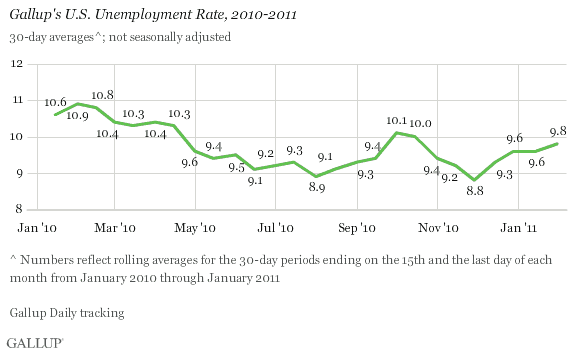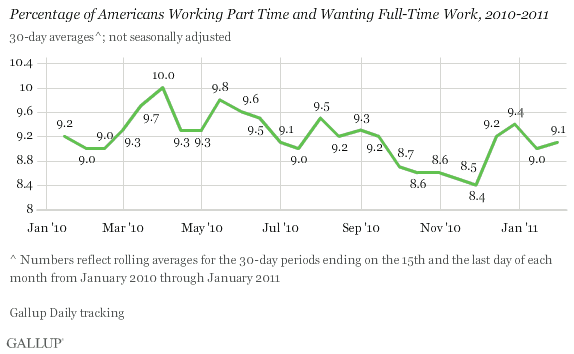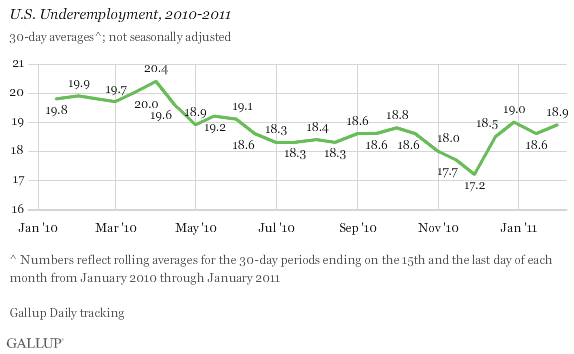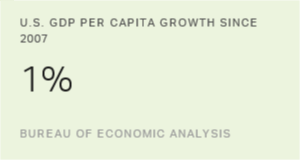PRINCETON, NJ -- Unemployment, as measured by Gallup without seasonal adjustment, increased to 9.8% at the end of January -- up from 9.6% at the end of December, but down from 10.9% a year ago.

The percentage of part-time workers who want full-time work improved slightly, to 9.1% of the workforce in January from 9.4% in December -- similar to the 9.0% of January 2010.

Underemployment Essentially Unchanged in January
Underemployment -- the combination of part-time workers wanting full-time work and Gallup's U.S. unemployment rate -- was 18.9% in January, essentially the same as the 19.0% of December. Underemployment now stands one percentage point below the 19.9% of a year ago.

The Real-Time Jobs Picture
Comparing Gallup's unemployment and underemployment rates so far in 2011 with those for the same periods in 2010 provides something of a seasonally adjusted view of Gallup's jobs data. Unemployment and underemployment are now at least one point below the rates of a year ago, reflecting modest improvement over the past year.
Still, Gallup's measures paint a real-time picture of the current job realities on the ground: nearly 1 in 10 Americans in the U.S. workforce are unemployed, nearly one out of five are underemployed, and the nation's overall hiring situation has not improved over the past four to six months.
Gallup.com reports results from these indexes in daily, weekly, and monthly averages and in Gallup.com stories. Complete trend data are always available to view and export in the following charts:
Daily: Employment, Economic Confidence and Job Creation, Consumer Spending
Weekly: Employment, Economic Confidence, Job Creation, Consumer Spending
Read more about Gallup's economic measures.
View our economic release schedule.
Survey Methods
Gallup's U.S. employment measures report the percentage of U.S. adults in the workforce, aged 18 and older, who are underemployed and unemployed, without seasonal adjustment. "Underemployed" respondents are employed part time, but want to work full time, or they are unemployed. Results for each 30-day rolling average are based on telephone interviews with approximately 30,000 adults. Because results are not seasonally adjusted, they are not directly comparable to numbers reported by the U.S. Bureau of Labor Statistics, which are based on workers aged 16 and older.
Results are based on telephone interviews conducted as part of Gallup Daily tracking Jan. 2-31, 2011, with a random sample of 18,213 adults, aged 18 and older, living in all 50 U.S. states and the District of Columbia, selected using random-digit-dial sampling.
For results based on the total sample of national adults, one can say with 95% confidence that the maximum margin of sampling error is ±0.7 percentage points.
Interviews are conducted with respondents on landline telephones and cellular phones, with interviews conducted in Spanish for respondents who are primarily Spanish-speaking. Each daily sample includes a minimum quota of 200 cell phone respondents and 800 landline respondents, with additional minimum quotas among landline respondents for gender within region. Landline respondents are chosen at random within each household on the basis of which member had the most recent birthday.
Samples are weighted by gender, age, race, Hispanic ethnicity, education, region, adults in the household, cell phone-only status, cell phone-mostly status, and phone lines. Demographic weighting targets are based on the March 2010 Current Population Survey figures for the aged 18 and older non-institutionalized population living in U.S. telephone households. All reported margins of sampling error include the computed design effects for weighting and sample design.
In addition to sampling error, question wording and practical difficulties in conducting surveys can introduce error or bias into the findings of public opinion polls.
For more details on Gallup's polling methodology, visit www.gallup.com.
